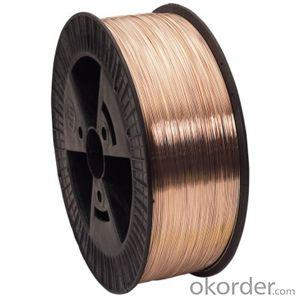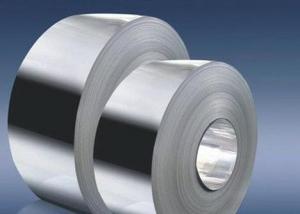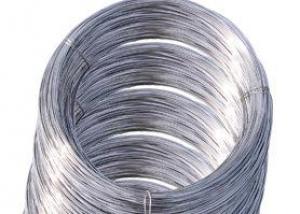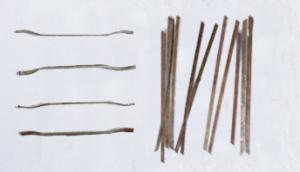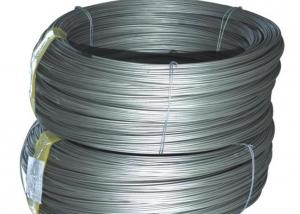welding wire/copper material CO2 gas shielded welding wire ER70S-6
- Loading Port:
- Qingdao
- Payment Terms:
- TT OR LC
- Min Order Qty:
- 10 m.t.
- Supply Capability:
- 1000 m.t./month
OKorder Service Pledge
OKorder Financial Service
You Might Also Like
Specifications
1.copper material CO2 gas shielded welding wire ER70S-6
2.diameter:0.80mm-2.0mm
3.spool weigh:1kg,5kg,15kg,20kg
4.manufacture
Company Profile of copper material CO2 gas shielded welding wire ER70S-6 :
Shandong Luli Steel Co. Ltd, founded in 1993, is a holding company of Luli Group,located in Weifang city, Shandong
province,China. It is a joint steel manufacturer which is combined with sintering, iron smelting, steel-making
and rolled products.Company owns production licenses of deformed bar and round bar and has passed ISO9001
international quality system authentication. Leading products include:
(1)12mm-350mm round bar
(2)6mm-40mm deformed steel bar
(3)0.80mm-2.0mm mig welding wire
Products have been exported to Korea, Japan and Southeast Asia with good reputation.Luli Steel Co., Ltd warmly
welcomes all the customers tovisit factory.If you are interested in our products,pls feel free to contact me.You
could also add me on WHATSAPP or SKYPE to contact in time.Detail contact information as follow:
Marks of copper material CO2 gas shielded welding wire ER70S-6 :
marks | applicable standards/models |
H08A | GB/T 5293 F4A2-H08A |
H08C | GB/T 5293 F4A2-H08A |
H08E | GB/T 5293 F4A2-H08A |
H08MnA | GB/T 5293 F5A2-H08A |
H10Mn2 | GB/T 5293 F4A2-H10Mn2 |
H10MnSi | AWS A5.17 F7A0-EM13K |
H08MnMoA | GB/T 12470 F5A2-H08MnMoA |
H08Mn2MoA | GB/T 12470 F69P2-H08Mn2MoA |
H08Mn2SiA | GB/T 5293 F5A2-H08Mn2SiA |
Chemical composition of copper material CO2 gas shielded welding wire ER70S-6 :
marks | chemical element | |||||||
C | Mn | Si | P | S | Ni | Mo | Ti | |
H08A | 0.07 | 0.40 | 0.021 | 0.014 | 0.011 | 0.008 | ||
H08C | 0.07 | 0.41 | 0.027 | 0.011 | 0.012 | 0.017 | ||
H08E | 0.08 | 0.50 | 0.026 | 0.011 | 0.010 | 0.016 | ||
H08MnA | 0.08 | 0.91 | 0.04 | 0.018 | 0.012 | 0.01 | ||
H10Mn2 | 0.07 | 1.61 | 0.03 | 0.012 | 0.011 | 0.008 | ||
H10MnSi | 0.05 | 0.95 | 0.64 | 0.015 | 0.013 | 0.007 | 0.38 | 0.06 |
H08MnMoA | 0.08 | 1.34 | 0.14 | 0.015 | 0.013 | 0.011 | 0.57 | 0.07 |
H08Mn2MoA | 0.08 | 1.71 | 0.18 | 0.016 | 0.013 | 0.011 | ||
H08Mn2SiA | 0.08 | 1.92 | 0.75 | 0.014 | 0.011 | 0.007 | ||
Mechanical property of copper material CO2 gas shielded welding wire ER70S-6 :
marks | mechanical property | |||
Tensile strength Rm(MPa) | Yield strength Rel or Rp0.2(MPa) | Elongation (%) | Impact energy (J) | |
H08A | 485 | 372 | 29 | 60(-20°C) |
H08C | 555 | 460 | 31 | 87(-20°C) |
H08E | 560 | 470 | 31 | 90(-20°C) |
H08MnA | 501 | 388 | 29 | 68(-20°C) |
H10Mn2 | 512 | 395 | 30 | 69(-20°C) |
H10MnSi | 538 | 427 | 31 | 98(-20°C) |
H08MnMoA | 618 | 495 | 25 | 101(-20°C) |
- Q:Is stainless steel wire suitable for architectural mesh applications?
- Indeed, architectural mesh applications greatly benefit from the use of stainless steel wire. Stainless steel, as a versatile material, possesses exceptional corrosion resistance, durability, and aesthetic appeal, rendering it a widely favored option for architectural purposes. With its strength and malleability, the wire enables the creation of intricate designs and patterns that enhance the aesthetic value of buildings and structures. The utilization of stainless steel wire in the production of architectural mesh presents numerous advantages. Firstly, it offers a remarkable level of transparency while ensuring privacy and security. The mesh can be woven in a myriad of patterns and densities, allowing for varying degrees of openness and visibility. This versatility makes it ideal for applications such as facades, partitions, sunshades, and cladding systems. Furthermore, stainless steel wire mesh exhibits exceptional durability and longevity, even when exposed to harsh environmental conditions. It remains resistant to corrosion, UV radiation, and fire, thereby preserving its structural integrity and aesthetics over time. Such longevity makes it a suitable choice for both indoor and outdoor applications, including building facades, ceilings, and decorative elements. Moreover, stainless steel wire mesh can be tailored to accommodate specific design requirements. It can be woven into various shapes, sizes, and patterns, empowering architects and designers to fashion unique and visually captivating structures. Additionally, the mesh can be coated or colored, providing further customization possibilities. In summary, stainless steel wire stands as an ideal material for architectural mesh applications due to its corrosion resistance, durability, customization options, and aesthetic appeal. It encompasses a fusion of functionality and visual allure, making it the preferred choice for architects and designers engaged in diverse architectural projects.
- Q:Can stainless steel wire screens be used for water filtration?
- Yes, stainless steel wire screens can be used for water filtration. Stainless steel is corrosion-resistant and durable, making it suitable for various filtration applications, including water filtration. The fine mesh of stainless steel screens can effectively remove particles and impurities from water, ensuring cleaner and safer water for consumption or industrial use.
- Q:What are the different types of stainless steel wire constructions?
- There exist various stainless steel wire constructions, each possessing distinct characteristics and applications. Below are some of the most frequently encountered types: 1. Plain Weave: The simplest and most widely employed stainless steel wire construction is the plain weave. It comprises interwoven wires in an alternating pattern, resulting in a durable and robust mesh. This type is commonly utilized in general industrial applications, filtration, and screening purposes. 2. Twilled Weave: Twilled weave stainless steel wire constructions are notable for their diagonal pattern formed by overlapping wires. This construction offers enhanced strength and stability compared to plain weave, making it suitable for applications requiring extra durability, such as heavy-duty filtration or sieving. 3. Dutch Weave: Dutch weave stainless steel wire constructions are renowned for their exceptional strength and fine filtration capabilities. In this type, the warp wires are thicker and closely spaced, while the weft wires are thinner and widely spaced. This unique construction permits precise and efficient filtration, rendering it ideal for applications involving liquids, gases, or fine particles. 4. Reverse Dutch Weave: Similar to Dutch weave, reverse Dutch weave stainless steel wire constructions have reversed wire positions. The warp wires are thinner and closely spaced, while the weft wires are thicker and widely spaced. This construction offers exceptional strength and rigidity, making it suitable for applications requiring high filtration efficiency and resistance to mechanical stress, such as pressure filters and hydraulic systems. 5. Welded Mesh: Welded mesh stainless steel wire constructions are formed by welding individual wires at their intersections. This construction produces a solid and rigid mesh that is resistant to deformation and exhibits excellent structural integrity. Welded mesh is commonly employed in fencing, enclosure panels, and concrete reinforcement applications. In summary, the selection of a stainless steel wire construction depends on specific application requirements, including strength, filtration efficiency, corrosion resistance, and durability. Each type possesses its own advantages and limitations, necessitating a comprehensive understanding of these differences for the appropriate selection of a stainless steel wire construction suitable for a particular purpose.
- Q:Is stainless steel wire resistant to crevice corrosion?
- Stainless steel wire typically exhibits resistance to crevice corrosion. Crevice corrosion arises when two surfaces are separated by a small gap or crevice, establishing a stagnant environment that fosters corrosion. However, stainless steel comprises a substantial amount of chromium, which generates a passive oxide layer on the surface, shielding against corrosion. This protective oxide layer serves as a barrier, impeding the infiltration of corrosive substances and obstructing the formation of crevice corrosion. Furthermore, stainless steel wire is frequently alloyed with additional elements like nickel and molybdenum, further augmenting its corrosion resistance, including crevice corrosion. Nevertheless, it is imperative to acknowledge that the level of resistance to crevice corrosion can fluctuate based on the specific grade and composition of the stainless steel wire.
- Q:Elevator hairline stainless steel and wire drawing stainless steel what is the difference between the two costs which expensive ah?
- Hairline stainless steel, that is, brushed stainless steel, hairline is from this kind of stainless steel product form definition, drawing is defined from the process, commonly known as drawing more, in fact, the same product is different name
- Q:Which kind of stainless steel welding wire is good? Is there any special regulation?
- The quality of the connection is good, but it is convenient to install the wire. You can choose it yourself
- Q:How does stainless steel wire perform in high-velocity environments?
- Stainless steel wire performs exceptionally well in high-velocity environments due to its inherent strength, durability, and corrosion resistance. It can withstand intense forces and maintain its structural integrity without succumbing to deformation or breakage. Additionally, its resistance to rust and other forms of corrosion ensures its longevity and reliability, making it an ideal choice for applications where speed and extreme conditions are involved.
- Q:What are the different types of stainless steel wire ropes used in marine applications?
- In marine applications, various stainless steel wire ropes are commonly employed due to their ability to endure the harsh conditions and corrosive environment of the marine industry. The following types are frequently utilized: 1. The 316 Stainless Steel Wire Rope is extensively employed in marine applications. It possesses remarkable corrosion resistance and can withstand exposure to saltwater and other corrosive elements. Moreover, it is renowned for its exceptional strength and durability. 2. The 304 Stainless Steel Wire Rope is also frequently utilized in marine applications. Although its corrosion resistance is not as high as the 316 stainless steel, it still offers good protection against corrosion. Additionally, it is recognized for its high tensile strength and resistance to abrasion. 3. The 316L Stainless Steel Wire Rope is a variation of the 316 stainless steel wire rope with lower carbon content. It provides similar corrosion resistance and strength properties as the 316 stainless steel. However, due to its reduced carbon content, it exhibits greater resistance to sensitization and intergranular corrosion. 4. The 7x19 Stainless Steel Wire Rope consists of 7 strands, with each strand containing 19 individual wires. This type of wire rope is known for its excellent flexibility and is commonly used in marine rigging, lifelines, and fishing nets that require high flexibility and corrosion resistance. 5. The 1x19 Stainless Steel Wire Rope consists of a single strand with 19 individual wires. It is recognized for its high tensile strength and is often utilized in standing rigging applications on sailboats, such as shrouds and stays. 6. The 7x7 Stainless Steel Wire Rope consists of 7 strands, with each strand containing 7 individual wires. It offers good flexibility and is commonly employed in applications that require moderate flexibility and corrosion resistance, such as guardrails and balustrades. 7. The 6x19 Stainless Steel Wire Rope consists of 6 strands, with each strand containing 19 individual wires. It strikes a balance between flexibility and strength and is frequently used in marine applications, including winches, cranes, and hoists. These examples represent just a few of the various types of stainless steel wire ropes utilized in marine applications. The selection of a specific wire rope type depends on the application's requirements, such as the desired level of corrosion resistance, strength, flexibility, and durability.
- Q:What are the different types of stainless steel wire used in musical instruments?
- Musical instruments rely on various stainless steel wire types for their construction. Among them, the widely used 304 stainless steel offers exceptional corrosion resistance and durability. This wire finds its application in guitar strings, piano wires, and certain brass instrument valves. Another stainless steel wire option for musical instruments is the 316 stainless steel. This alloy boasts a higher proportion of nickel and molybdenum, which significantly enhances its resistance to corrosion, particularly in harsh environments like marine settings. Wind instruments such as saxophones, trumpets, and trombones commonly utilize 316 stainless steel wire. Furthermore, specialized stainless steel wires cater to specific musical instruments. For instance, piano strings often incorporate 17-7 PH stainless steel wire due to its superior tensile strength and corrosion resistance. This wire contributes to the production of a resonant and rich sound in pianos. In summary, the selection of stainless steel wire for musical instruments depends on multiple factors such as the instrument type, desired sound quality, and environmental conditions. Manufacturers diligently choose the appropriate stainless steel wire type to ensure optimal performance, durability, and corrosion resistance for each musical instrument.
- Q:Is stainless steel wire suitable for wire rope hooks?
- Yes, stainless steel wire is suitable for wire rope hooks. Stainless steel is known for its corrosion resistance, strength, and durability, making it an excellent choice for wire rope hooks. It can withstand harsh environments, including exposure to water, chemicals, and extreme temperatures, without rusting or deteriorating. Additionally, stainless steel wire has high tensile strength, which is crucial for maintaining the integrity and safety of wire rope hooks. Therefore, using stainless steel wire for wire rope hooks ensures reliability, longevity, and optimal performance.
1. Manufacturer Overview |
|
|---|---|
| Location | |
| Year Established | |
| Annual Output Value | |
| Main Markets | |
| Company Certifications | |
2. Manufacturer Certificates |
|
|---|---|
| a) Certification Name | |
| Range | |
| Reference | |
| Validity Period | |
3. Manufacturer Capability |
|
|---|---|
| a)Trade Capacity | |
| Nearest Port | |
| Export Percentage | |
| No.of Employees in Trade Department | |
| Language Spoken: | |
| b)Factory Information | |
| Factory Size: | |
| No. of Production Lines | |
| Contract Manufacturing | |
| Product Price Range | |
Send your message to us
welding wire/copper material CO2 gas shielded welding wire ER70S-6
- Loading Port:
- Qingdao
- Payment Terms:
- TT OR LC
- Min Order Qty:
- 10 m.t.
- Supply Capability:
- 1000 m.t./month
OKorder Service Pledge
OKorder Financial Service
Similar products
New products
Hot products
Related keywords
